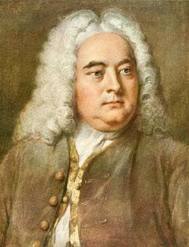Annotation:Melancholy Nymph: Difference between revisions
No edit summary |
No edit summary |
||
| Line 2: | Line 2: | ||
---- | ---- | ||
<p><font face="garamond, serif" size="4"> | <p><font face="garamond, serif" size="4"> | ||
'''MELANCHOLY NYMPH.''' AKA and see "'Twas when the sea was | '''MELANCHOLY NYMPH.''' AKA and see "Faithful maid (The)," "'Twas when the sea was roaring." The air was composed and set by the classical composer George Freidric Handel (1685-1759) for John Gay's '''The What d'ye Call it?''' (1715), and was adapted for Air 28 in Gay's later work '''The Beggar's Opera''' (for Lucy's song "How cruel are the traitors." It appears in '''Calliope''' (1746, part 1, No. 168), John Sadler's '''Muses Delight''' (1754, p. 176), and similar songsters, and was printed on single sheets. | ||
[[File:handel.jpg|200px|thumb|left|George F. Handel]] | [[File:handel.jpg|200px|thumb|left|George F. Handel]] | ||
<br> | <br> | ||
| Line 18: | Line 18: | ||
</font></p> | </font></p> | ||
<p><font face="garamond, serif" size="4"> | <p><font face="garamond, serif" size="4"> | ||
''Recorded sources'': <font color=teal>Avie AV2102, Emma Curtis - "Calliope" (2006).</font> | ''Recorded sources'': <font color=teal>Avie AV2102, Emma Curtis - "Calliope: Volume the First" (2006). Avie 2153, Brook Street Band, Sally Bruce-Payne, Nicki Kennedy- "Handel's English Cantatas" (2008). </font> | ||
</font></p> | </font></p> | ||
<br> | <br> | ||
Revision as of 15:44, 26 September 2013
Back to Melancholy Nymph
MELANCHOLY NYMPH. AKA and see "Faithful maid (The)," "'Twas when the sea was roaring." The air was composed and set by the classical composer George Freidric Handel (1685-1759) for John Gay's The What d'ye Call it? (1715), and was adapted for Air 28 in Gay's later work The Beggar's Opera (for Lucy's song "How cruel are the traitors." It appears in Calliope (1746, part 1, No. 168), John Sadler's Muses Delight (1754, p. 176), and similar songsters, and was printed on single sheets.

Source for notated version:
Printed sources:
Recorded sources: Avie AV2102, Emma Curtis - "Calliope: Volume the First" (2006). Avie 2153, Brook Street Band, Sally Bruce-Payne, Nicki Kennedy- "Handel's English Cantatas" (2008).
